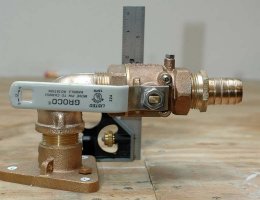Seth wrote in another thread:
Seth, et al-
I'm in the process of doing a major overhaul on everything below the waterline (peel, barrier job, replacing all and relocating some thru hulls, etc). A couple of questions for anyone who wishes to comment:
1) I contacted Centek industries, who make fire-retardant fiberglass wet exhaust fittings. They can make a standard 'Y' hose fitting that accepts two 1.5" hoses and outputs them to a single 2" hose (see this link: http://www.centekindustries.com/fittings.html - The 1.5" to 2" fitting is not listed but they are willing to make two of them for me for about $50 each). I was thinking of leading a set of two 1.5" scupper lines to each Y then completing the run to a 2" thru-hull. I would double clamp and use crush sleeves, and since it is rated for wet exhaust, they say it is fine for below WL use. If I maximized the length of the 2" run (ie, placed the Y as close as possible to the aft-most scupper), would this achieve what you are suggesting?
2) In an effort to minimize holes below the waterline and minimize winterization concerns, I'm strongly considering relocating the thru-hulls for the scuppers to just above the waterline. I'd use Groco flange adapters on two 2" thru-hulls, then to a 90-degree street-el, terminating to a valve/barb. That should keep the overall height of the valve assembly as low as possible, and allow a downward slope on the 2" hose from the Y fitting to this assembly. I know the horizontal valve assembly is not as ideal as a seacock, but it is reinforced by the flange, and can be additionally reinforced at the barb end, plus it's above the WL. See the attached photo (thanks to MaineSail's blog on pbase.com, btw, a WEALTH of valuable info - see it at http://www.pbase.com/mainecruising/boat_projects). I might opt for a 45-degree turn instead of 90 degree to accomodate the slope of the hull, to keep the assembly level and prevent it from pointing downward).
Is there anything in my logic or approach that is problematic?
I appreciate any feedback.
Thanks.
Well, good luck. I would suggest 2 things to look very hard at:
1). Cockpit drains. Increase the diameter of the hoses so that the cockpit will drain as fast as possible-shoot for under 2 minutes.
It WILL get flooded, and the boat is very vulnerable when the cockpit is full of water. This 2 minute test is a requirement for offshore racing yachts.
Seth, et al-
I'm in the process of doing a major overhaul on everything below the waterline (peel, barrier job, replacing all and relocating some thru hulls, etc). A couple of questions for anyone who wishes to comment:
1) I contacted Centek industries, who make fire-retardant fiberglass wet exhaust fittings. They can make a standard 'Y' hose fitting that accepts two 1.5" hoses and outputs them to a single 2" hose (see this link: http://www.centekindustries.com/fittings.html - The 1.5" to 2" fitting is not listed but they are willing to make two of them for me for about $50 each). I was thinking of leading a set of two 1.5" scupper lines to each Y then completing the run to a 2" thru-hull. I would double clamp and use crush sleeves, and since it is rated for wet exhaust, they say it is fine for below WL use. If I maximized the length of the 2" run (ie, placed the Y as close as possible to the aft-most scupper), would this achieve what you are suggesting?
2) In an effort to minimize holes below the waterline and minimize winterization concerns, I'm strongly considering relocating the thru-hulls for the scuppers to just above the waterline. I'd use Groco flange adapters on two 2" thru-hulls, then to a 90-degree street-el, terminating to a valve/barb. That should keep the overall height of the valve assembly as low as possible, and allow a downward slope on the 2" hose from the Y fitting to this assembly. I know the horizontal valve assembly is not as ideal as a seacock, but it is reinforced by the flange, and can be additionally reinforced at the barb end, plus it's above the WL. See the attached photo (thanks to MaineSail's blog on pbase.com, btw, a WEALTH of valuable info - see it at http://www.pbase.com/mainecruising/boat_projects). I might opt for a 45-degree turn instead of 90 degree to accomodate the slope of the hull, to keep the assembly level and prevent it from pointing downward).
Is there anything in my logic or approach that is problematic?
I appreciate any feedback.
Thanks.


